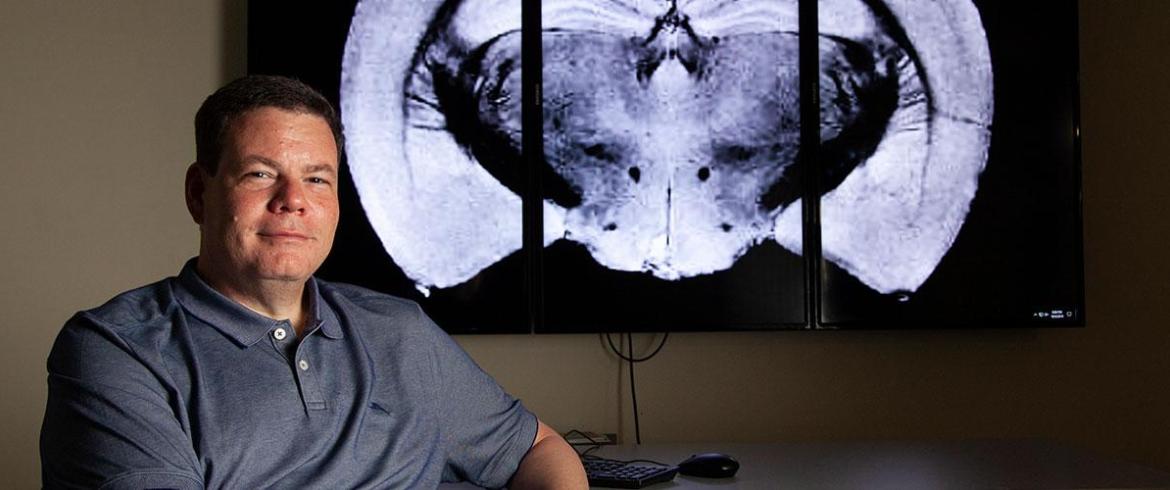
Dr. Sam Grant uses the imaging power of a 21 Tesla magnet to see inside the brain during migraine. With the unique capabilities provided by magnetic resonance imaging (MRI) at the National High Magnetic Field Laboratory, Grant and his team have identified what may be an important component of migraine propagation through the human brain.
This article was featured in the Annual Engineering Research Report (2019-2020).
Could simple sodium be the secret to how migraine spreads through the human brain?
Despite migraine being the sixth-most-debilitating illness in the world—with healthcare and lost productivity costs estimated to be as much as $36 billion in the U.S. alone—why it occurs and how it propagates in the brain has not been well understood.
With the help of a $3.3 million, five-year National Institutes of Health (NIH) grant, chemical and biomedical engineering researchers from the FAMU-FSU College of Engineering are hoping to solve the riddle using the strongest MRI scanner in the world at the nearby National High Magnetic Field Laboratory (MagLab).
In research over the past five years, Samuel Grant, associate professor and graduate program coordinator in the Department of Chemical and Biomedical Engineering, and graduate student Nastaren Abad have identified a likely suspect—sodium.
Using the MagLab’s powerful 21 Tesla magnet, the researchers are able to create high-resolution, dynamic images that target and follow sodium atoms that would be impossible to see with clinical MRIs.
“We can see things that other people can’t see,” he said. “That’s why our collaborator, Mike Harrington, director of neurosciences at Huntington Medical Research Institute (HMRI) in Pasadena, California, came to us in the first place.” Many things can “trigger” migraine, said Grant, including light, sound, foods, odors and atmospheric changes.
“We think sodium isn’t necessarily the trigger for migraine, but it seems to be, or has the potential to be, a common way that migraine is propagated,” he said. “Sodium is the medium by which that initial trigger, whatever it might be, actually moves around the brain and institutes what we consider to be the full-blown migraine attack. We think it is actually somewhat ubiquitous in its role across different triggers. So, if we can interrupt that cascade of what happens with regards to sodium, then we might be able to stop the attack before it really begins.”
When sodium floods into areas of the brain, the brain expends energy trying to correct the imbalance, causing pain.
“ We don’t think sodium is necessarily the trigger for migraine, but it seems to be—or has the potential to be—a common way that migraine is propagated.”

“By that time, the cascade and the imbalances we’re talking about have already set in. You’re well down the path to migraine by that point, and now you’re dealing with how you’re going manage the pain and other effects,” he explained. “Being able to have something that gives feedback to the person to say, ‘Hey, there’s a migraine attack coming’ before it starts is not easy. That’s one thing we’re trying to resolve.”
“There’s a lot happening before you physically feel it,” said Abad, who herself suffers from migraine triggered by thunderstorms. Her attacks usually last five or six hours. Statistically, women tend to get the painful, localized headaches—which can last from three to 72 hours in susceptible individuals—more than men.
The hypersensitivity to things like light, smell and touch that accompanies migraine means sufferers usually have to drop their daily routine and retreat to a quiet place or sleep it off. “Once I have it, I turn into a recluse,” Abad said.
The MRI imaging is done using rats—they’re the right size to fit into the magnet’s bore—and sodium in the brain is tracked while the animals are in the midst of a medication-induced migraine attack.
“We’ve mostly focused on acute migraine,” Grant said. “But the funding will allow us to start to look at chronic migraine, which may be even a better model in some respects for patients.”
Grant likens the physical harm caused by chronic migraine to a person with high blood pressure. A single spike in blood pressure after exertion isn’t cause for concern, but continuous high blood pressure can have an effect throughout the body.
“A single event or migraine attack has repercussions over the short term,” Grant explained. “But it’s the accumulation of such events that impacts the brain chronically. This series of events then remodels metabolism and blood flow in the brain, causing significant alteration over time.”
The group has been studying pain relievers such as the first-line treatment sumatriptan, and also plans to look at a new class of experimental medicines specifically targeting migraine—known as gepants—that are in clinical trials now.
Collaborators in the NIH grant include Harrington and Linda Petzold, a professor of computer science and mechanical engineering at the University of California Santa Barbara (UCSB).
Each institution is contributing in a unique way, according to Grant. The HMRI team is conducting behavioral and tissue studies using animal models; the UCSB group is developing computer models of sodium transport in the brain; and Grant’s team is running high-field sodium MRI and metabolic spectroscopy experiments. By combining these methods, they hope to understand how migraine is perpetuated via sodium.
